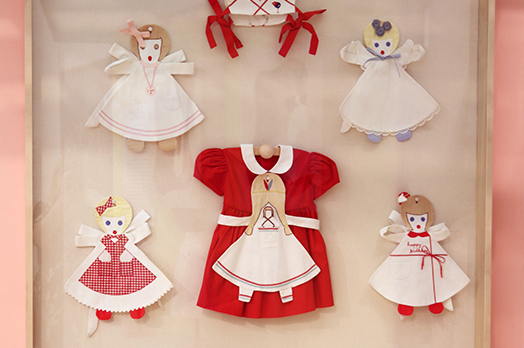Florence Eiseman designs embody the 20th century child
Garments from University's historic costume collection displayed at Museum of Wisconsin Art.
Through history, children mirrored what adults would wear. But Eiseman's clothing is a reflection of being a child, it is playful and innocent.
Sarah Eichhorn
Mount Mary University Fashion Department
With simple lines, playful embellishments and bright colors, Milwaukee designer Florence Eiseman (1899-1988) created a signature look for children that is both recognizable and enduring.
The Museum of Wisconsin Art (MoWA) is featuring "Florence Eiseman: Designing Childhood for the American Century," a 70-year retrospective of Eiseman's work that borrows heavily from Mount Mary's Eiseman collection. It will be on display through Oct. 8.
MoWA Executive Director Laurie Winters calls Eiseman "one of Milwaukee's most notable creative visionaries." According to the museum's catalog, Eiseman's design mantra was to "make a child look like a child."
"She started a clothing line for children in the 1940s that shaped the look of the American child for decades to come," Winters said. "Her A-line shapes and graphic appliqués, pinafores, and even a luxury cruise collection for children provide a lens through which American cultural history can be viewed, underscoring how significant fashion is as an art form."
Her designs underscored American's postwar image of the idyllic, child-centered nuclear family. This paradigm shift from the past represented not only a change in design aesthetic, but represented a change in the perception of childhood itself, said Sarah Eichhorn of Mount Mary's fashion department.
"Through history, children mirrored what adults would wear," Eichhorn explained. "But Eiseman's clothing is a reflection of being a child, it is playful and innocent."
Eiseman's styles were worn by some of the most famous children of the mid-twentieth century, including Carrie Fisher, daughter of Hollywood star Debbie Reynolds, young John and Caroline Kennedy, and the daughters of Princess Grace of Monaco.
The design house remains relevant today; while in office, President Obama and Michelle Obama commissioned the brand to create baby gifts that were given during the Obama administration. The new generation of Eiseman children include Suri Cruise, daughter of actors Katie Holmes and Tom Cruise. In 2012, Blue Ivy Carter, daughter of entertainers Beyoncé and Shawn "Jay Z" Carter, wore a Florence Eiseman dress to the 2012 presidential inauguration of Barack Obama.
Mount Mary has a significant number of Eiseman pieces in the historic costume collection, these pieces represent the university's interest in preserving the history of fashion design in Milwaukee, Eichhorn said. Over a dozen pieces are on display at the MoWA exhibit.
The pieces on display belonging to Mount Mary include rompers, dresses, a swimsuit, bib and apron. It also includes a collection of whimsical, themed pinafores that are meant to be buttoned and worn on the front of a dress.
If you go: The Eiseman exhibit is one of four exhibits at the museum that focus on Wisconsin fashion. One of these, Contemporary Threads: Wisconsin Fashion, features the work of designers with phenomenal national presences, four of whom competed on Project Runway and one who designed for Lady Gaga.
Mount Mary alumna Sara Terrell, '10, has a number of garments on display in this exhibit. On August 12, she will present a hands-on class on "upcycling," the process of upgrading and modifying existing garments. Learn more.
Opportunities to embrace Eiseman designs
If you would like to learn more about the work of Milwaukee designer Florence Eiseman, here are a number of opportunities at the Museum of Wisconsin Art:
- A panel discussion with exhibit curators for “Florence Eiseman: Designing Childhood for the American Century,” will be held from 2 to 3:30 p.m. Saturday, July 15 at MoWA. They will discuss the rise of this design legend.
- Curator Natalie Wright will give a short presentation on Eiseman’s concept of universal design, and the various design modifications used by Eiseman to accommodate children with various abilities and disabilities from noon to 12:20 p.m. Thursday, August 3. Some of these features included longer hems to accommodate crutches and large buttons making it easier for children to maneuver independently.
